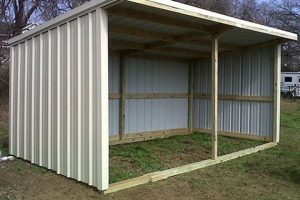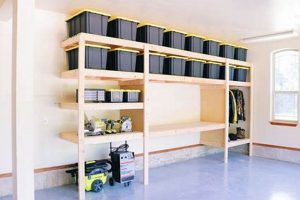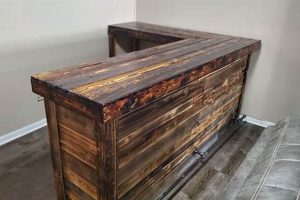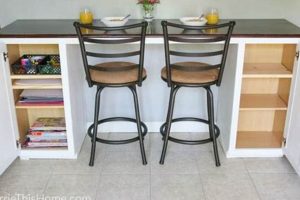Constructions combining seating with space for footwear present a practical solution for organization and convenience, particularly in entryways and mudrooms. These structures offer a designated area to sit while removing or putting on shoes, while simultaneously providing concealed or open compartments for storing footwear, thereby minimizing clutter. A typical example involves a wooden structure with a hinged seat that lifts to reveal storage space.
Such furniture pieces are valuable for their space-saving capabilities and dual functionality. They consolidate two common needsseating and storageinto a single item, optimizing the use of available space. Historically, similar furniture designs have been employed in various cultures to address the perennial problem of managing footwear and maintaining tidy living areas. The design promotes both aesthetic appeal and functional efficiency.
The following sections will explore different construction methods, design considerations, material choices, and customization options applicable to creating this type of furniture. The emphasis will be placed on practical guidance suitable for individuals with varying levels of woodworking experience.
Construction Guidelines
The following guidelines provide essential considerations for successful creation of the desired furniture piece, ensuring both structural integrity and aesthetic appeal.
Tip 1: Material Selection: Prioritize hardwood lumber, such as oak or maple, for load-bearing components to ensure longevity and stability. Softwoods like pine are suitable for less stressed elements like drawer boxes or interior dividers. Proper sealing is essential to prevent moisture damage.
Tip 2: Precise Measurements: Accurate measurement and cutting are crucial. A detailed plan, accounting for the thickness of all materials, should be followed rigorously. Deviations can compromise the structural integrity and visual appearance of the final product.
Tip 3: Joint Strength: Employ robust joinery techniques such as mortise-and-tenon, dovetail, or pocket-hole joints for structural integrity. Reinforce joints with wood glue and screws or nails as appropriate. Select appropriate fasteners based on material and load requirements.
Tip 4: Seating Comfort: Consider the ergonomic aspects of the seating surface. Implement a slight contour or select upholstery with appropriate padding to maximize comfort. Ensure that the seat height is suitable for its intended users.
Tip 5: Adequate Ventilation: When designing enclosed storage, ensure adequate ventilation to prevent the buildup of moisture and odors. Drill ventilation holes or integrate mesh panels into the design. This is particularly important for storing damp footwear.
Tip 6: Safety Considerations: Sand all surfaces to remove splinters and sharp edges. Use non-toxic finishes and sealants. If the design includes a hinged seat, incorporate soft-close hinges to prevent accidental slamming and potential injury.
Tip 7: Finish Application: Apply multiple thin coats of finish rather than a single thick coat to achieve a durable and visually appealing surface. Allow each coat to dry thoroughly before applying the next. Consider the impact of the chosen finish on the wood’s appearance.
Adhering to these guidelines promotes a durable, functional, and aesthetically pleasing outcome. Careful planning and execution are essential for success.
The subsequent section will delve into design variations and customization opportunities available for enhancing both functionality and aesthetic appeal.
1. Dimensions
Spatial considerations are paramount in the design and construction of combined seating and storage furniture. The dimensions directly influence functionality, capacity, and aesthetic integration within the designated space. Optimal dimensional planning enhances usability and visual harmony.
- Overall Footprint
The external measurements, encompassing width, depth, and height, dictate the furniture’s spatial consumption. A compact footprint is crucial in confined entryways, while larger dimensions can accommodate greater storage capacity in spacious areas. The overall size must align with the available floor space to prevent obstruction of movement or visual imbalance. For example, a bench exceeding the width of an entryway creates a bottleneck, hindering traffic flow.
- Seating Height and Depth
The vertical distance from the floor to the seating surface is critical for ergonomic comfort. Standard seating height typically ranges from 16 to 20 inches, accommodating a comfortable seated posture for most adults. The seat depth influences the available seating area and affects legroom. Insufficient depth can lead to discomfort, while excessive depth may hinder ease of getting up.
- Storage Compartment Size
Internal dimensions of storage spaces directly affect the quantity and type of footwear that can be accommodated. Compartment height should accommodate various shoe types, including boots. Width and depth determine the number of pairs that can be stored side-by-side or front-to-back. Inadequate compartment dimensions lead to disorganized storage and reduced usability.
- Bench Height relative to Shoe Storage
When the shoe storage section of a diy shoe storage bench is being built, the height of the bench above it should be considered carefully. A bench that is too short will hinder proper seating and look proportionally smaller. A bench that is too high will create unnecessary space in the storage, as well as risk being proportionally too tall. A proper height should be determined to maximize the potential of diy shoe storage bench.
Precise attention to dimensions, their interplay, and their relationship to the intended environment ensures the successful integration of seating and storage capabilities. Optimal dimensional planning yields a functional and aesthetically pleasing addition to any space.
2. Materials
The selection of appropriate materials is fundamental to the structural integrity, longevity, and aesthetic appeal of seating and storage structures. Material properties directly influence the furniture’s resistance to wear and tear, stability under load, and susceptibility to environmental factors such as moisture and temperature variations. For example, using untreated softwood in a high-humidity environment leads to warping, rot, and eventual structural failure. Conversely, the application of a durable hardwood with a protective finish can ensure decades of reliable use.
Material choices affect not only structural performance but also the overall design aesthetic. Solid wood provides a classic and durable option, allowing for various finishes and intricate detailing. Plywood offers a cost-effective alternative, providing dimensional stability and a smooth surface for painting or veneering. Metal components, such as frames or legs, can introduce a modern or industrial aesthetic while enhancing structural support. Upholstery fabrics affect seating comfort and visual style, requiring selection based on durability, cleanability, and color coordination with the surrounding environment.
Ultimately, the material selection process is a critical aspect of construction, requiring a comprehensive understanding of material properties, structural requirements, and desired aesthetic outcomes. Informed material choices ensure the creation of durable, functional, and visually pleasing seating and storage solutions.
3. Joinery
The integrity and longevity of combined seating and storage furniture are fundamentally dependent on the quality and appropriateness of the joinery techniques employed. The methods used to connect individual components dictate the structure’s resistance to stress, stability under load, and overall durability. The selection and execution of robust joinery are therefore critical to the success of the build.
- Mortise and Tenon
This traditional technique involves fitting a projecting tenon from one piece of wood into a precisely cut mortise on another. It provides exceptional strength and resistance to racking forces, making it suitable for joining legs to the seat frame or constructing sturdy shelving within storage compartments. Its interlocking nature resists separation under stress, ensuring structural integrity over time. Example: Connecting the bench legs to the seat frame.
- Dovetail Joints
Characterized by interlocking, fan-shaped projections, dovetail joints offer superior tensile strength and resistance to pulling forces. They are commonly used in drawer construction, ensuring the drawer box remains intact under repeated use. The mechanical interlock prevents the drawer from separating at the joints, even under heavy loads. Example: Constructing drawers for shoe storage.
- Pocket Hole Joinery
This technique utilizes angled pilot holes drilled into one workpiece, allowing screws to be driven into an adjacent piece. While not as visually appealing as traditional joinery, pocket holes provide a fast and efficient method for assembling frames and boxes. When combined with wood glue, they offer adequate strength for many applications. Example: Assembling the main cabinet body.
- Dado Joints
Dado joints involve cutting a rectangular channel (dado) into one piece of wood to receive another. This provides a strong and stable connection for shelves or dividers, preventing them from sagging or shifting under load. Dadoes offer greater surface area for glue adhesion compared to simple butt joints. Example: Installing shelves within the shoe storage compartment.
The selection of appropriate joinery techniques, combined with precise execution, enhances the longevity, stability, and overall quality of the furniture piece. While aesthetic considerations may influence the choice of certain joints, the primary focus should remain on ensuring structural integrity and long-term performance.
4. Hardware
Hardware components are integral to the functionality, durability, and aesthetic of a constructed shoe storage bench. The selection of appropriate hardware influences the ease of use, structural integrity, and overall lifespan of the furniture piece.
- Hinges
Hinges facilitate the pivotal movement of doors or seat lids, providing access to storage compartments. The type of hinge selected dictates the range of motion, weight capacity, and visual appearance. Concealed hinges offer a clean, minimalist aesthetic, while butt hinges provide robust support for heavier lids. Soft-close hinges enhance user safety and prevent slamming. Inadequate hinge selection compromises functionality and potentially damages the structure. Example: Selecting heavy-duty hinges for a bench with a solid wood lid.
- Drawer Slides
Drawer slides enable smooth and controlled drawer movement within the storage bench. Ball-bearing slides offer superior load capacity and smoother operation compared to friction slides. Full-extension slides allow complete access to the drawer contents, while undermount slides provide a clean, seamless aesthetic. The selection of appropriate drawer slides ensures ease of use and extends the lifespan of the drawer system. Example: Utilizing full-extension ball-bearing slides for a deep drawer storing multiple pairs of shoes.
- Fasteners
Screws, nails, and bolts are employed to join various components of the storage bench. The type and size of fastener must be appropriate for the materials being joined and the loads they will bear. Wood screws provide superior holding power compared to nails in wood construction. Bolts are used for high-stress connections requiring maximum strength. The correct selection and application of fasteners prevent structural failure and ensure long-term stability. Example: Using wood screws with pilot holes to secure the frame members of the bench.
- Knobs and Pulls
Knobs and pulls provide a grip for opening doors and drawers, enhancing user convenience and contributing to the overall aesthetic. The style and material of the knobs and pulls should complement the design of the bench. Ergonomic considerations, such as size and shape, influence ease of use. Durable materials, such as metal or solid wood, withstand repeated handling. Example: Installing brushed nickel pulls on drawers for a contemporary aesthetic.
The careful selection and installation of appropriate hardware components are essential for optimizing the functionality, durability, and visual appeal of combined seating and storage furniture. Hardware choices directly impact user experience and the long-term performance of the furniture piece.
5. Seating
The integration of seating into a footwear storage structure fundamentally alters the function and utility of the furniture. The seating component provides a designated location for users to comfortably remove or put on shoes, addressing a common need in entryways and mudrooms. Without integrated seating, individuals are compelled to balance or crouch, which is particularly challenging for those with mobility limitations or when handling bulky footwear. The addition of seating promotes safer and more convenient transitions between indoor and outdoor footwear.
The design of the seating area impacts the overall effectiveness of the structure. Ergonomic considerations, such as seat height, depth, and the presence of back support, influence user comfort. A seat that is too low or too deep can cause discomfort or difficulty rising. Materials used for the seating surface affect durability and cleanability. Upholstered seats provide greater comfort but may require more maintenance than solid wood surfaces. The integration of seating necessarily increases the overall footprint of the storage unit, necessitating careful consideration of available space. Examples include hallways, mudroom.
In summary, seating is a crucial element in the functionality of a footwear storage bench, providing convenience, safety, and enhanced usability. Design considerations related to ergonomics, materials, and spatial constraints are paramount in creating an effective integrated seating and storage solution. The absence of comfortable and accessible seating detracts from the overall utility of the designed item.
6. Storage
The primary function of a footwear storage bench lies in its storage capacity. The provision of organized space for footwear is the defining characteristic of such furniture. Without adequate and well-designed storage compartments, the bench fails to fulfill its core purpose. The capacity and configuration of the storage component directly influence the utility and practicality of the entire structure. For instance, a bench with insufficient storage volume or poorly arranged compartments will result in cluttered and inaccessible footwear. This defeats the purpose of having dedicated storage.
The design of the storage element must consider the types and quantities of footwear to be accommodated. Compartment dimensions, shelving configurations, and ventilation are critical design considerations. Small compartments limit the storage of larger shoe sizes or boots, reducing the bench’s overall utility. Insufficient ventilation leads to moisture buildup and unpleasant odors. The storage portion should optimize space while ensuring easy access and organization. An example of effective storage design involves adjustable shelves to accommodate different shoe heights and ventilation slots to promote airflow.
In essence, the storage component is the core functional element of the footwear storage bench. Its design and execution directly determine the practical value and effectiveness of the furniture. Overlooking the importance of storage capacity, compartment configuration, and ventilation compromises the functionality of the entire structure.
7. Finish
The final surface treatment, commonly referred to as the “finish,” is a critical determinant of the aesthetic appeal, durability, and long-term performance of a combined seating and storage furniture piece. This layer provides protection against environmental factors while enhancing the visual characteristics of the underlying material. The careful selection and application of an appropriate finish is therefore an essential step in the construction of any such furniture.
- Protection Against Moisture and Wear
A properly applied finish acts as a barrier against moisture penetration, preventing warping, swelling, and rot in wooden components. It also provides a durable surface that resists scratches, abrasions, and stains from daily use. Examples include polyurethane for high-traffic areas and varnish for a more traditional aesthetic. The choice of finish significantly extends the lifespan of the bench by safeguarding it from common forms of damage.
- Aesthetic Enhancement
The finish accentuates the natural grain and color of the wood, enhancing its visual appeal. Stains can be used to alter the wood’s tone, while clear coats preserve its original appearance. The finish also affects the sheen level, ranging from matte to high gloss, influencing the overall style of the furniture. Consider the overall aesthetic of the entryway or mudroom when selecting the finish to ensure visual harmony.
- Ease of Maintenance
Certain finishes offer superior resistance to dirt and grime, simplifying cleaning and maintenance. Polyurethane and lacquer, for instance, create a smooth, non-porous surface that is easily wiped clean. A well-chosen finish minimizes the effort required to maintain the bench’s appearance over time. This is particularly important for furniture intended for use in high-traffic areas.
- Impact on Indoor Air Quality
The finish choice has implications for indoor air quality, particularly in enclosed spaces. Low-VOC (volatile organic compound) finishes minimize the emission of harmful chemicals, promoting a healthier environment. Water-based finishes are generally considered to be safer than solvent-based options. Select finishes that comply with environmental regulations and prioritize user health.
The application of an appropriate finish is essential for ensuring the long-term performance, visual appeal, and environmental safety of seating and storage furniture. Considerations such as moisture resistance, aesthetic enhancement, ease of maintenance, and impact on indoor air quality are crucial to making an informed decision.
Frequently Asked Questions
This section addresses common inquiries regarding the design, construction, and maintenance of furniture integrating seating with footwear storage capabilities.
Question 1: What types of wood are most suitable for constructing a durable seating and storage combination?
Hardwoods such as oak, maple, and birch provide superior strength and resistance to wear, making them ideal for load-bearing components. Softwoods like pine or fir can be used for less critical elements, but require proper sealing and finishing to prevent damage.
Question 2: How can one ensure adequate ventilation within enclosed footwear storage compartments?
Ventilation can be achieved through the inclusion of strategically placed ventilation holes, mesh panels, or gaps between storage compartments. These features facilitate airflow and prevent the accumulation of moisture and odors.
Question 3: What joinery techniques are recommended for constructing a structurally sound seating and storage unit?
Mortise-and-tenon joints, dovetail joints, and pocket-hole joints are effective methods for creating strong and stable connections. The selection of a specific technique depends on the materials used, the intended load, and the desired aesthetic.
Question 4: How does one determine the optimal dimensions for a seating and storage bench in a limited space?
Careful measurement of the available space is essential. Consider the height, width, and depth of the bench in relation to the surrounding environment. Prioritize functionality and comfort while minimizing obstruction of movement.
Question 5: What types of finishes provide the best protection against moisture and wear for a seating and storage unit?
Polyurethane, varnish, and lacquer offer durable and water-resistant finishes. Multiple thin coats are preferable to a single thick coat. Proper surface preparation is crucial for optimal adhesion and performance.
Question 6: How can seating be incorporated ergonomically into a footwear storage bench design?
Maintain a seat height of approximately 16 to 20 inches for comfortable seating. Consider the inclusion of a slightly contoured seat surface or the addition of upholstery for enhanced comfort. Ensure adequate legroom and back support, if applicable.
The preceding answers provide essential guidance for creating a functional and durable furniture piece. Thoughtful planning and attention to detail are crucial for a successful project.
The following section will explore design variations and potential customizations applicable to enhance this type of furniture.
Conclusion
The preceding exploration of the diy shoe storage bench concept has elucidated key considerations for its successful design and construction. Material selection, joinery techniques, dimensional planning, and finish application are all critical factors influencing the furniture’s longevity, functionality, and aesthetic integration within a space. Effective implementation of these principles yields a valuable addition to residential environments.
The design and construction of a functional and aesthetically pleasing structure demands careful consideration of the principles outlined. It promotes an organized living space and represents a worthwhile investment in both home functionality and personal craftsmanship.







